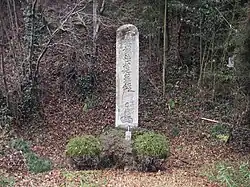南無妙法蓮華経
See also: 南無妙法蓮華經
Japanese
| Kanji in this term | ||||||
|---|---|---|---|---|---|---|
| 南 | 無 | 妙 | 法 | 蓮 | 華 | 経 |
| な Grade: 2 |
む Grade: 4 |
みょう Grade: S |
ほう Grade: 4 |
れん Jinmeiyō |
げ Grade: S |
きょう Grade: 5 |
| kan’yōon | goon | |||||
| Alternative spelling |
|---|
| 南無妙法蓮華經 (kyūjitai) |

南無妙法蓮華経 (Namu Myōhō Renge Kyō): a slab with the inscription of Namu Myōhō Renge Kyō in Fujikawa, Shizuoka
Etymology
From 南無 (namu, Buddhist salutation or expression of faith) + 妙法蓮華経 (Myōhō Renge Kyō, “Lotus Sutra”).[1][2][3]
Usage notes
- Namu Myoho Renge Kyō is the most common pronunciation of the mantra; but there are also variants:
- Nichiren Shōshū uses なんみょうほうれんげきょう (Nam Myōhō Renge Kyō).
- The Tendai school mainly uses なもべいほうれんがけい (Namo Beihō Renga-kei), a mostly kan'on pronunciation of the kanji.
- The ascetic Honzan sect of Tendai uses a mixed goon-kan’on reading of なむべいはれんがけい (Namu Beiha Renga-kei).
See also
References
- “南無妙法蓮華経”, in 日本大百科全書:ニッポニカ (Nippon Dai Hyakka Zensho: Nipponica, “Encyclopedia Nipponica”) (in Japanese), Tōkyō: Shogakukan, 1984
- Matsumura, Akira, editor (2006), 大辞林 [Daijirin] (in Japanese), Third edition, Tōkyō: Sanseidō, →ISBN
- “南無妙法蓮華経”, in ブリタニカ国際大百科事典 小項目事典 (Buritanika Kokusai Dai Hyakka Jiten: Shō Kōmoku Jiten, “Encyclopædia Britannica International: Micropædia”) (in Japanese), Tōkyō: Britannica Japan Co., Ltd., 2014
This article is issued from Wiktionary. The text is licensed under Creative Commons - Attribution - Sharealike. Additional terms may apply for the media files.